 Author
Michael Davi, Ekaterinburg
Author
Michael Davi, Ekaterinburg
JANNU, North Face. Michael
Davi's story.
“Remember that not getting what
you want
Is sometimes a wonderful stroke of luck”.
Dalai Lama
I've never understood this phrase.
Now, apparently, I start to understand. The good climber differs from
… more likely not from bad, but from dead the fact that he is able to
turn back in the right time. I think, we turned in the right time from
the North Face of Jannu during this expedition. We could try to climb
upwards, but that it would be more difficult to turn, when there would
be some hundreds meters up to the top. However the quantity of troubles
escorting this expedition already exceeded allowable limits … All began
not so poorly. We made quite successful acclimatization on Khan Tengri.
We believed in the favourable numerology – it was the seventh top in
the project “Big Wall - Russian way", the top of the altitude of 7700
meters, there were 7 climbers in the crew. However the troubles began
at once on arrival to Nepal. Because of strong rains it was washed away
the airport in Taplejung village and planes did not fly - we had to
go by bus, the roads were washed away too. Having stood in traffic lasting
many hours, we went longer, than it was planned.
|

|
Having arrived to the settlement
Fidim, we were waiting for the helicopter for two days, but all of them
were mobilized by the police and the Army because of the political situation
and we decided to go with a caravan on foot. All the day we went 20
kilometres on a straight road up to Taplejung, the lorry with the cargo
came only next day. But, at last, the caravan was organized, all cargoes
were distributed into usual porters including women who carried on 30
kg, but some rather puny boys took a double cargo, i.e. 60 kg! All our
way along a track we intense expected of meeting with Maoists. They,
as it was said, plundered and gathered all foreigners, but fortunately
we avoided this trouble - to Russians they concerned a little bit better,
than to Americans. It is no accident that they have got the red flag
with a sickle and a hammer. We went in a rather intense rate, 10 - 12
hours per day actually without a dinner, with a small snack in the middle
of the day. I was attacked with some cold and I went really on the autopilot.
The track went highly on slopes overgrown with bamboo thrickets and
descended again downwards. In a result for a day it was possible to
climb on only 500 meters, having climbed on a way more than two kilometres.
For the third day we already came in Gunza - the last settlement on
out way before the base camp.
|

|
There is an interesting division
of labour at local residents. You have to hire drovers and yaks to carry
your cargo upward from that place. While we were waiting the porters
left behind and negotiating about drovers and yaks we could have a day
of rest. The places there were fantastic - for the first time during
our way we could see a rather wide equal valley with a lot of waterfalls,
coniferous woods with birch mushrooms, aspen mushrooms, milk mushrooms
and white mushrooms, on its boards and hardly higher there were thrickets
of dwarfish sea-buckthorn berries.
|

|
The next day we left in last part
of our way up to the base camp. We went before the turn of the valley
and suddenly, in a break of clouds, somewhere in unreal high sky chasm
there appeared a fantastic silhouette of Jannu or Kumbakarna as it is
named by locals. Some minutes we were standing and looking and we couldn't
tear off a sight. The steep rocky northern face that we saw on all photos
almost without snow now was completely white.
We went three - four hours more upwards
along the lateral gorge and came into the base camp. It was the place
even more beautiful, than we could imagine - a plane glade covered with
grass and even small bushes. There were a waterfall, a stream with crystal-clear
water there. And directly opposite, covering with itself of the half-sky,
the huge Wall of Jannu towered up. The altitude of the base camp was
about 4700 meters, i.e. up to the top there still were 3 kilometres
on a vertical and hardly probable more than that on whole across.
|
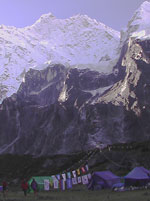
|
The weather held cloudy, we couldn't
almost see the Wall and the route via the icefall, but we had no a lot
of time, therefore already on September 10 Ruchkin, Mikhailov and Totmyanin
went out to work out the ice-fall. First day they made 16 pitchers,
Alex and I dragged them more ropes and descended. The next day they
made some more pitches upwards and came up against the bottomless cracks.
Some of them they could jump over, but then the cracks became wider
and they had to turn back. The guys spent the night on a small plane
platform on a serac.
|
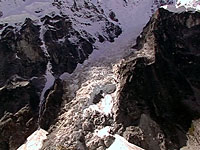
|
As Ruchkin said, they fell the impressions
that they were spending the night between trains as there constantly
were ice collapses from the left and from the right by turns. Next day
we decided to change our tactics - I climbed on an opposite slope with
a field-glass and a portable radio set and corrected the Ruchkin's movement
on the ice-fall. In places Sanya jumped over the cracks with two ice
axes in hands, sticking them in ice, it was direct like as “Vertical
Unlimit”.
|
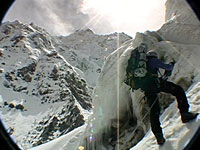
|
At last we found the exit on rocks;
I descended, crossed the glacier and made some pitches on the fixed
rope after the first two-men. On the rocky board of the ice-fall there
was a convenient platform where I and Alex Bolotov set the Camp I, and
the other guys decided to climb without luggage upwards as much as possible.
And already almost in twilight, we heard the hoarse voice of Ruchkin
in a portable radio set: “We have a problem, Mike has nailed with the
ice, we are descending. Please, meet us with drink and warm clothes”.
We gathered quickly and we almost ran upwards as far as we could do
it at 5300 meters. When we met Mike, he was too bad, he could descend
on the abrupt ropes somehow in his own, overcoming his pain, but he
couldn't go through the snow on the moraine. We tried to drag him on
snow putting him on a backpack, but it caused him too much pain. Then
Alex hoisted him onto his back and, supported from the both sides, carried
him up to the camp.
|
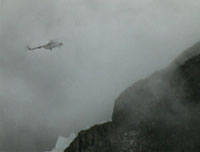
|
Next morning Odintsov and Pershin
left with medicines upward, and I and Bolotov began to fix the ropes
directly downwards, on an abrupt rock wall as we couldn't transport
Mike via the ice-fall and to go on it was extremely dangerous. All this
time we had the intense negotiations with helicopter pilots. Small helicopters
agreed to fly only up to the base camp, and asked for such heroic flight
huge money - up to 30 thousand dollars. At last, we could agree with
MI-8 MTV, The pilot promised to fly and try to take Mike off directly
from the camp at 5300m in despite of the very small and rough platform
there. We had one more problem - the weather. The camp where Mike stayed
was constantly covered with clouds; it was drizzling all the times.
We spent a day of painful expectation interrupted by a bell of a satellite
phone - the pilot called, and told: “We are already flying ”! The pilot
appeared Russian! It raised hopes in breast, that, when he arrived,
he would do his best to carry out the task. However he made even almost
impossible - having hardly gained the altitude in the narrow gorge and
waited the break in clouds, he was managed from the fifth attempt to
put a forward wheel to the platform, take Mike aboard, and fly away.
Right after that the cloudiness finally lowered and it began raining
till the evening.
|
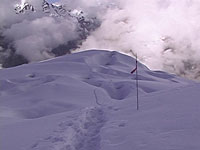
|
In the evening all the left team
gathered below and discussed the developed situation. On a twist of
fate though all of us were on the objectively dangerous ice-fall for
some days, Mike was pressed down actually on the last dangerous site
with the last hanging serac. Therefore, taking into account the successful
evacuation of him, and the fact that the ropes now already went on a
rock site, instead of on the ice-fall, we decided to continue our ascent.
We divided into three two-men team; they were planned to work by turns
- for three - four days. Alex and I went out first. Having loaded full
backpacks and loaded them some more on the track under the wall, I understood
on the middle of the pitch, that such cargo was too heavy for me. I
had to share it and descended in the morning for the left half of the
cargo.
|
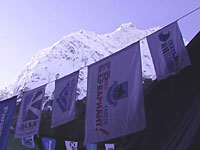
|
Then we climbed on the fixed ropes
upward to the place of the accident, and fixed some more ropes up to
the plateau. And there was a very convenient platform on a rocky ledge
where we settled the camp. A rather flat snow-ice plateau extended from
there up to the Wall, but strongly torn by cracks. Having strayed a
little, we found almost ideal passage on it and marked it with bamboo
landmarks, which we had reserved on our way. The couloir on which the
majority of the expeditions before us went on, looked very scare - a
narrow ice trench with a huge snow cone below and traces of recent avalanches.
We decided to go to the left from the couloir, on the border of snow
and rocks, where it seemed was the less avalanche danger. Next day Alex
made six pitches on abrupt ice site covered with fresh snow, I was the
belayer. After a dinner the traditional snowfall began. It started to
cover us with the real small avalanches even on our safer route.
But finally Pershin and Totmyanin
changed us over, and we descended to the base camp. These first moments
of returning from the snows to the greens and smells of grasses, perhaps,
were the most pleasant moments of the expedition. Then, after we spent
a day or two in the base camp the feelings became blunt, and everything
was remarked not so bright, we were only preparing for the next exit
upwards. While we relaxed in the base camp, the attack on the wall went
on, but the rates of moving ahead were reduced. The slope became hardly
gently sloping, but the amount of snow increased. To fix a rope meant
that we had to dig a hole with a depth about 1,5 meter. The weather,
as before, was not good: it was raining below, and it was snowing upper,
but according to the forecast the monsoon would already end from day
to day though.
|
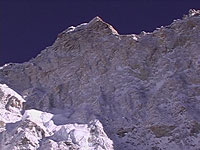
|
When Alex and I climbed again, six
ropes more were added to the six ones fixed by us and it was the right
time to set the next camp. Under the snow-fall we left after the advanced
two-men and Ruchkin and I together dug and moulded the platform for
setting a small double tent on a snow crest. Two Alexanders descended
downwards, and Alex and I stayed to spend the night. We couldn't asleep
almost all the night, it was very cold and constantly there were avalanche
collapses, thank God, that they weren't coming over us yet. Since the
morning it was snowing too. Having waited for a gleam, we descended
for the cargo left on the fixed ropes. After a dinner I tried to climb
upwards, but, having climbed ten meters via the abrupt rock filled with
ice and covered with snow, I had to turn back because of the new snowfall.
The next day the weather was hardly better, and Alex, ploughing the
snow as a tank, made the whole seven pitches upwards, doing the points
on dug sacks filled with snow. The relief was rather unusual - snow
couloirs and crests broke the whole slope, in one of which, it seemed
it was possible to dig out a snow cave. Clouds tightened everything
below. It was raining with a snow in the base camp all the day long,
but here we could work more or less. According to that fact nobody left
to change us over, and I and Alex continued to work a little. Till a
dinner we made four pitches more and descended: Alex – was going to
descend straight away to the base camp, but I - up to 5600m where we
met Pershin and Totmyanin climbed up. On the evening communication it
became known, that Sanya Odintsov received a stone on his hand and dropped
out for uncertain time. Thus it became already five of us, and we didn't
reach the basic Wall yet. The route from the base camp up to the end
of the fixed ropes began to take away more and more time and forces,
which already left less and less. As I counted later, on this expedition
I went upwards and, accordingly, then also downwards 220 pitches.
There was a hobby in the base camp
- to observe in a telescope the moving of the advanced two-men, seeing
that the weather was adjusted. And it was visible according of the speed
of moving on the fixed ropes, that Nick Totmyanin felt himself perfectly,
than Pershin. We discussed with Odintsov where to set the next camp.
He suggested to hang up a portaledge on rocks at about 6700m, but I
was convinced, that it was possible to dig out a cave in a snow ridge
at 6500 then we would remove the small tent settled by us. One of the
arguments against the cave was that fact that three men together had
to dig the cave all the day. Our dispute decided by Nick who alone,
is literally for a pair of hours, dug out a rather cosy cave. The next
day he and Mike made some more pitches via the rocks, bypassing the
first ice pillow, and Mike descended to rest. Ruchkin ascended to the
cave to change him over, and I and Alex at that time climbed up to 5600m.
In the evening it began hardly snowing and it was going on all the night.
In the morning we found the tent covered with a thick blanket of snow,
and everywhere avalanches roar were sounding. Under the plan we had
to ascend that day up to the cave, and Nick and Sanya had to work upper
and then to descend to rest. However the snowfall didn't come to the
end and we couldn't climb upwards in no way - small avalanches were
constantly collapsing from above, not allowing to make a step. Sanya
and Nick became tired of sitting by the sea and waiting for fair weather
and descended after a dinner. Alex and I stayed one more day at 5600
and because there wasn't any gleam in a snowfall, followed their example.
|

|
In the base camp already third week
there was no communication with Continent. The satellite phone Thuraya
caught some screw-ups right after the rescue of Mike Mikhaylov and stopped
to be connected to the network. We had two devices of Globalstar system,
but, unfortunately, the territory of Nepal did not become covered by
this system though there was the signal from the satellite there. The
unique way of communication was to go to Gunza, and there to order negotiations
on a portable radio set from Katmandu which would take place only next
day. Our mood was on zero - it was already October on a calendar, and
a kilometre of very abrupt wall was still ahead of us. However when
in couple of days the snow ended, and the hope appeared again in our
souls. To save the time and our forces, we decided to not descended
any more to the base camp, and to have a rest at 5600 for what we lifted
there a heap of usual products - noodles, rice and so on, as we already
had the high-altitude products only just enough.
|
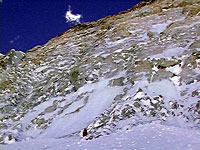
|
It took us two days to ascend on
the fixed ropes covered with the snow up to the cave. Ruchkin made some
more pitches for a day, and for the fourth day we went out already with
the gear to organize the last camp before the final rocky wall, at the
altitude about 7000 meters. The sun didn't shine this part of the wall
at all, and, despite of the clear weather, the terrible winter cold
stood there all the day. We had to wrap up as we could to climb on the
abrupt fixed ropes with the gear and to belay. I reached the snow slope
under the wall the last, and I hardly persuaded Alex to dig a cave a
bit more to the left, on a small snow ridge as by that time he was already
going to hang up a portaledge on a rock. However the cave turned out
even better than the previous one, the only thing, disturbed us was
the fact, that there was some suspicious emptiness between the snow
and the ice, and we hoped that all this slope wouldn't depart with us
together. The next morning Sanya and Alex made the first pitch on a
rocky Wall. It was very abrupt, practically steep, there were lenses
of the strongest ice there and we couldn't use ice-screws and beat tools
on them. In this time I collected our deserved platform with inscription
"Manaraga" and that was not completely simple: I was alone, there was
a frost, the altitude was of 7000 meters and the snow slope was abrupt.
After a dinner Nick ascended to us from below in the always-vigorous
mood. He lifted to us a heap of ropes. Later Mike ascended too. In the
evening we descended at 5600m. The mood was again nasty - the fried
meat which Pershin and Nick left for us near to the tent and hid under
the stones, was devoured with ravens; up to top with our rates was not
less than two weeks under condition of a good weather; despite of again
worked e-mail (Igor brought a new phone from Katmandu) there wasn't
any letters from a house. However as it is said the night is the good
doctor of our souls. And in the morning I was ready again to beat up
to the end and to do my best to help the advanced two-climbers to blaze
the route. It was possible to observe their movings from the tent even
without the field-glass: now they left the cave, ascended up to the
end of the fixed ropes and... again descended to the cave. At that altitude
was such cold, that Mike had his feet completely frozen in his double
boots with sewed overboots. They decided to descend at 5600 to put on
one more overboots, and then they again climbed upper. It turned out
we had nothing to do there we stayed and we descended to the base camp
too. Next day it began raining again. And it often was passing into
snowing and it was lasting not ceasing, almost for three days.
Even in the base camp, at the temperature
about 0 degrees, there was a lot of snow, and above the snow in general
filled up everything. Nick and Mike was staying in the tent at 5600
and asked to tell them even a joke on a portable radio set, because
they had absolutely nothing to do there. In air the clear understanding
hung that we had no chance to summit the top in this season, but nobody
started to talk on this theme. At last, I asked Odintsov that we would
do, in fact it was clear, that we wouldn't successfully ascend. He unexpectedly
easily agreed: "Yes, now we will not climb. But we have to do our best
to do it in the spring. For this purpose we have to preserve the camps
and to fix a pair of ropes on the Wall". At once there appeared a simplification
as Nikita Khruschev spoke: "The Purposes are set, the tasks are clear
- go to work, comrades!" Having waited for the end of a snowfall, we
climbed again, removed the camp, Alex and Nick fixed two ropes more
on the Wall, reaching the altitude of 7200 meters. I preserved the camp
at 5600, and packed three full trunks and we hid them in a secluded
place, since according to Igor information, the locals promised to climb
and take away everything that they would find after our departure. Though
I somehow badly present, as it can be possible. So in the spring the
expedition of the project "Big Wall-Russian Way" will have quite good
chances for the success. And I am glad, that the representatives of
Ekaterinburg: Alexey Bolotov, Sergey Borisov and Michael Pershin will
take part in it, though the last one is now already living more in St.
Petersburg. Well and I, following the other advice of the Dalai Lama:
"Once a year, go someplace you've never been before", probably, I will
go to any other place, in fact the world is so great, and there are
a lot of places where I haven't been yet....

